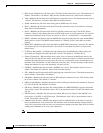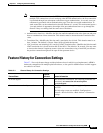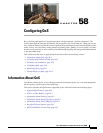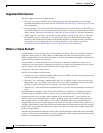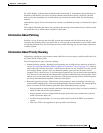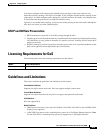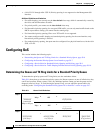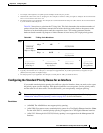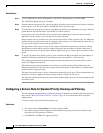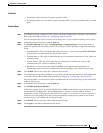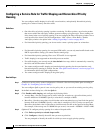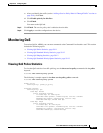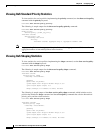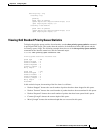
58-6
Cisco ASA 5500 Series Configuration Guide using ASDM
Chapter 58 Configuring QoS
Configuring QoS
• (ASA 5512-X through ASA 5555-X) Priority queuing is not supported on the Management 0/0
interface.
Additional Guidelines and Limitations
• For traffic shaping, you can only use the class-default class map, which is automatically created by
the ASA, and which matches all traffic.
• For priority traffic, you cannot use the class-default class map.
• For hierarchical priority queuing, for encrypted VPN traffic, you can only match traffic based on the
DSCP or precedence setting; you cannot match a tunnel group.
• For hierarchical priority queuing, IPsec-over-TCP traffic is not supported.
• You cannot configure traffic shaping and standard priority queuing for the same interface; only
hierarchical priority queuing is allowed.
• For standard priority queuing, the queue must be configured for a physical interface or, for the ASA
5505, a VLAN.
Configuring QoS
This section includes the following topics:
• Determining the Queue and TX Ring Limits for a Standard Priority Queue, page 58-6
• Configuring the Standard Priority Queue for an Interface, page 58-7
• Configuring a Service Rule for Standard Priority Queuing and Policing, page 58-8
• Configuring a Service Rule for Traffic Shaping and Hierarchical Priority Queuing, page 58-10
Determining the Queue and TX Ring Limits for a Standard Priority Queue
To determine the priority queue and TX ring limits, use the worksheets below.
Table 58-1 shows how to calculate the priority queue size. Because queues are not of infinite size, they
can fill and overflow. When a queue is full, any additional packets cannot get into the queue and are
dropped (called tail drop). To avoid having the queue fill up, you can adjust the queue buffer size
according to the “Configuring the Standard Priority Queue for an Interface” section on page 58-7.
Table 58-1 Queue Limit Worksheet
Step 1
__________
Outbound
bandwidth
(Mbps or Kbps)
1
Mbps
x
125
=
__________
# of bytes/ms
Kbps
x
.125
=
__________
# of bytes/ms
Step 2
___________
# of bytes/ms
from Step 1
÷
__________
Average packet
size (bytes)
2
x
__________
Delay (ms)
3
=
__________
Queue limit
(# of packets)



